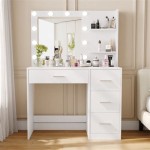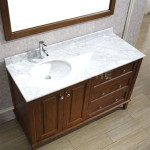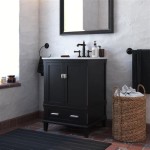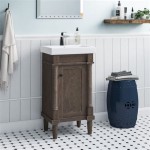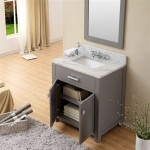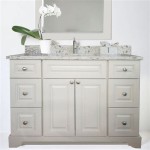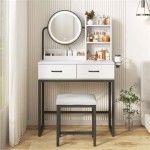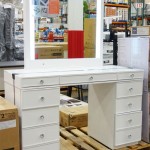Bathroom Vanity With Open Bottom: Style and Functionality
The bathroom vanity serves as a focal point in the bathroom, offering both aesthetic appeal and practical storage solutions. While traditional vanities often feature enclosed cabinet spaces, the bathroom vanity with an open bottom presents a unique design alternative. This style emphasizes visual lightness, accessibility, and a modern aesthetic, making it a popular choice for contemporary bathroom designs. This article explores the key features, benefits, design considerations, and practical applications of bathroom vanities with open bottoms.
The Appeal of Open Bottom Vanities
Open bottom vanities offer a distinct aesthetic that differs significantly from their enclosed counterparts. The absence of traditional cabinet doors and drawers generates a sense of spaciousness, particularly beneficial in smaller bathrooms. This design minimizes the visual weight of the vanity, allowing more of the floor to be visible and creating an airier feel. The exposed plumbing and support structures, typically obscured by cabinets, become part of the design aesthetic, often complementing industrial or minimalist themes. This openness allows for creative storage solutions that deviate from the standard cabinetry arrangement.
Beyond aesthetics, accessibility is a key advantage of open bottom vanities. Items stored beneath the sink are readily accessible, eliminating the need to open doors or drawers. This is particularly useful for frequently used items such as towels, baskets containing toiletries, or decorative elements. Individuals with mobility limitations may also find open bottom vanities more user-friendly, as they offer easier access to the sink and storage without the need for bending or straining to reach into enclosed cabinets.
Furthermore, open bottom vanities can be more cost-effective than their enclosed counterparts. The simplified construction, often requiring fewer materials and less labor, can translate into lower purchase prices. This makes them an attractive option for budget-conscious homeowners who still desire a stylish and functional bathroom.
Design Considerations for Open Bottom Vanities
Selecting the right open bottom vanity requires careful consideration of several factors to ensure a cohesive and functional bathroom design. The overall style of the bathroom plays a crucial role. Open bottom vanities typically lend themselves well to modern, minimalist, industrial, and Scandinavian design aesthetics. However, with appropriate material and finish choices, they can also be incorporated into transitional or even rustic bathroom styles.
The type of sink to be used in conjunction with the vanity is also important. Vessel sinks, which sit atop the vanity counter, are a popular choice for open bottom vanities, as they contribute to the overall visual height and draw attention to the exposed base. Undermount sinks, which are installed beneath the counter, create a cleaner, more streamlined look. The choice between these sink types depends on personal preference and the desired aesthetic.
Material selection is critical. The vanity top material must be durable and water-resistant. Popular choices include granite, quartz, marble, and solid surface materials. The base material can vary widely, from wood and metal to concrete and even reclaimed materials. The chosen material should complement the overall bathroom décor and be able to withstand the humidity and moisture typically present in a bathroom environment.
Plumbing considerations are paramount. With an open bottom vanity, the plumbing is exposed, meaning neat and organized plumbing is essential for maintaining a visually pleasing aesthetic. Chrome or brushed nickel pipes and fittings are often preferred for their clean and modern look. Concealing pipes as much as possible, while still maintaining accessibility for maintenance, is a key consideration. Professional plumbers can assist in designing a plumbing configuration that is both functional and aesthetically pleasing.
Storage solutions for open bottom vanities require creativity and planning. Baskets, bins, and open shelving are common ways to organize items beneath the sink. These storage solutions should be chosen to complement the overall bathroom décor and provide ample space for frequently used toiletries, towels, and other bathroom essentials. The size and configuration of the storage solutions should be carefully considered to avoid clutter and maintain a visually appealing space. Rolling carts can also be used to provide additional storage and mobility.
Practical Applications and Benefits
Open bottom vanities are particularly well-suited for smaller bathrooms where space is at a premium. The visual airiness created by the absence of cabinets helps to make the bathroom feel larger and more open. This is especially beneficial in powder rooms or guest bathrooms where storage requirements may be less demanding.
In master bathrooms, open bottom vanities can create a spa-like atmosphere. Combining the vanity with natural materials, such as wood and stone, and incorporating plants or decorative elements can enhance the sense of relaxation and tranquility. The open space beneath the sink can also be used to display decorative towels or create a small seating area.
Open bottom vanities are also a good choice for bathrooms used by individuals with mobility limitations. The absence of cabinets allows for easier access to the sink and storage areas, making it more comfortable and convenient for individuals using wheelchairs or other mobility aids. The open space beneath the sink can also provide clearance for wheelchairs to roll up to the vanity.
Furthermore, open bottom vanities can be a sustainable choice. Reclaimed wood or other recycled materials can be used in the construction of the vanity base, reducing the environmental impact of the project. The simplified design also often requires fewer materials and less energy to manufacture compared to traditional enclosed vanities.
Finally, open bottom vanities offer flexibility in terms of design and customization. The absence of cabinets allows for a wider range of design options, from minimalist metal frames to rustic wood bases. Homeowners can easily customize the vanity to suit their individual needs and preferences, creating a truly unique and personalized bathroom space.
Maintenance of open bottom vanities requires attention to detail. Because the plumbing and storage areas are exposed, regular cleaning is essential to prevent dust and grime from accumulating. Wiping down the pipes and storage containers regularly will help to maintain a clean and organized appearance. Careful selection of durable and water-resistant materials for the vanity base and top will also help to ensure its longevity.

Open Bottom Vanity Shelf Design Ideas

15 Examples Of Bathroom Vanities That Have Open Shelving

Design Element London 72 Double Bathroom Vanity With Open Bottom White Carrera Countertop Sinks And Mirrors Pearl

Open Bottom Vanity Shelf Design Ideas

How To Know If An Open Bathroom Vanity Is For You

Open Shelf Bathroom Vanity Hunker

Sagehill Designs Toby 36 Free Standing Single Bathroom Vanity With Open Bottom Shelf In Casual Taupe

15 Examples Of Bathroom Vanities That Have Open Shelving

Bathroom Design Tip Add Open Shelving To The Bottom Of Your Cabinets

An Introduction To Open Shelf Bathroom Vanities
